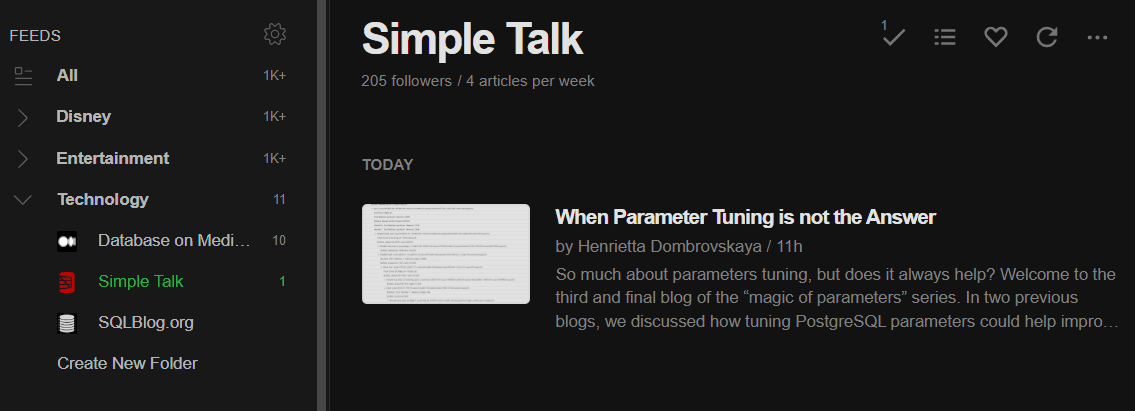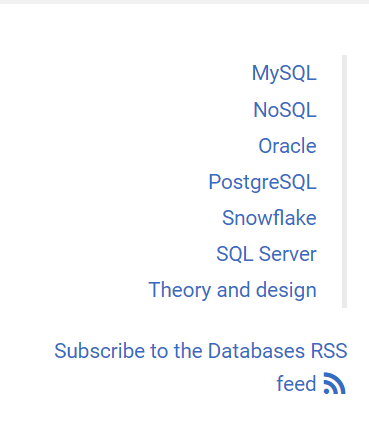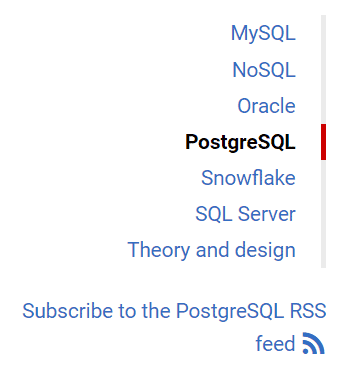Recently, we have made a few changes to the simple-talk.com website’s RSS feeds that I am pretty excited about. If you don’t know what RSS feeds are, they are links that let you pull down content from a website not the formatted view you typically see, but instead in an XML document that other tools can ingest naturally.
There are many uses for RSS feeds, but the two I frequently use are:
Syndicate blogs and content For example to share my personal blogs to my website (you can see how it comes out as stubs here: https://drsql.org/blog)
To read web pages in one place The latter is something I have been doing for many many years. Using an RSS feed reader, you take the feed URL (which I will cover Simple-Talk’s URLs in detail later in this blog), and then you can see new articles and for many sites, ours included, you can read the article right in the feed tool.
The most famous (and most famously dead) RSS feed reader tool was Google Reader. Even if it was 10 years ago that it went away, it still stings. Though it felt like it at the time, that wasn’t the end of RSS feeds, and new readers stepped in to take their place. You can read about the RSS Feed readers that exist today in this Wired article that had been recently updated when I wrote this blog. I have used Newsblur and Feedly and both do great. Some of the tools on the list will be free too.
For example, this is my current view:

After I read the new blogs on Simple Talk, I will check out other database blogs, then head off to see what is changing in theme parks.
As mentioned, we do not limit what you can see in the feed. This gives you the ability to read our articles right in the reader of your choice. This is really useful for reading on a mobile device. (Of course, for programming heavy articles, you probably will end up reading on your computer if you want to follow along with the code!)
Note: If you ever find content that is unreadable (either for formatting or content!), please drop us an email at editor@simple.talk and let us know. Sometimes it may not be fixable, but always want the content to look good no matter where it shows up.
How to access the feed URL
No matter how you use RSS feeds, the key to fetching the data is the address of the feed. Recently we made some changes to our site to make it a bit easier to find. After showing you the location in the graphical pages, I will also show you how to grab your own feed URLs, using a method that works on pretty much any WordPress site. (Note, they have their own RSS feed reader mentioned in the article!)
Full Site
In the upper right hand corner of the Simple-Talk site there will be the following icon:

This is the RSS symbol (I know it looks a lot like WiFi, but it isn’t!). This will give you the feed URL for all the articles and blogs that you see on the site. This value for our site is:
https://www.red-gate.com/simple-talk/feed/
This pattern is base URL (simple-talk.com redirects to https://ift.tt/KaJGsp1) + feed/. This is very handy tool, and you can pretty much add /feed/ to the end of any WordPress URL and get the feed for that site. Your mileage may vary, but it can be useful.
Categories
Honestly the biggest reason I would use anything other than the full site RSS feed is for a site like Simple-Talk. As not only an editor, but a programmer of over 25 years, I know that most of our readers will not want to see every article we publish. We cover a variety of topics, and you may only want to see a subset. You may be a SQL Server programmer, or a PostgreSQL one, or a .NET programmer. We have a plethora of different topic that we cover.
If you click on any of the topics (other than Home and Blogs, which are special):

On the sidebar, you will see the method to get the RSS feed URL for that category (it shows up in individual blogs as well):

If you drill in, you can subscribe to just PostgreSQL posts, or just SQL Server. SQL Server breaks down further than the others at this point, which is a work in progress.

Just like before, you can get the feed URL by taking the page URL, which for PostgreSQL is: https://www.red-gate.com/simple-talk/databases/postgresql and add feed to it to get the feed URL: https://www.red-gate.com/simple-talk/databases/postgresql/feed/
Authors
When I said Home and Blogs were special, it is because these are not really things you would want to subscribe to directly. These articles will all show up in the topic areas as well. Blogs are written by our authors, but they are not typically sorted into categories.
Blogs are typically followed based on the author doing the writing. For the simple talk editor, you would see this view:

The URL is https://www.red-gate.com/simple-talk/author/simple-talk/, and from the RSS symbol you could get the feed URL of https://www.red-gate.com/simple-talk/author/simple-talk/feed/.
Summary
RSS feeds are an awesome way to set yourself up with content to read or display as it comes in, without having to surf to every webpage over and over (or copy and paste the content). Simple-Talk makes it easy for you to read our content as it comes in along with as many other sites as you want.
Note: For sites that are filled with too much advertising, a good RSS feed reader can help you cut through the muck and get to the content you want to read. You may still have advertisements, but the list usually will be cleaner.
Hope this is helpful to you!
The post Simple-Talk RSS Feeds appeared first on Simple Talk.
from Simple Talk https://ift.tt/Ws6rwlS
via
No comments:
Post a Comment